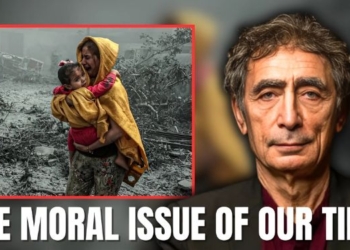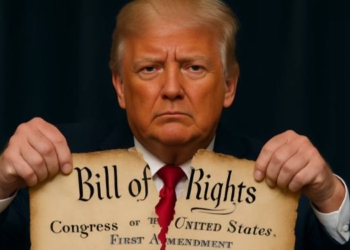
By Forrest Rivers
For a long time now, Americans have been hopelessly divided by politics, religion, wealth, geography, and race. Liberals vs conservatives, religious fundamentalists vs atheists, rich vs poor, urban dwellers vs rural farmers, the white race vs just about every other racial minority group. So, is it really a surprise that this division has spilled over into peoples’ reactions to COVID-19? Combine a terrifying public health crisis with a catastrophic economic collapse and you have the recipe for social conflict. In the context of the public’s reaction to the pandemic, there are two groups who have emerged in opposition to one another. On the one hand, are those people who contend (through citing medical evidence) that this virus is absolutely one of the greatest existential threats that we have faced in over a hundred years. Not surprisingly, they believe that state governments should be doing everything that is in their power to protect citizens from the pandemic—- even if it means resigning countless millions to dire poverty through mandated shutdowns and handing state governments temporary authoritarian powers to do so. On the other hand, are those who believe that COVID-19 has been badly “overblown” by media outlets who have an incentive to engineering a climate of fear in order to rack in record corporate profits. People with this belief hold that millions of hard-working Americans were needlessly laid off from their jobs and that the shutdowns should end immediately—- even if it comes at the cost of a massive spike in deaths among America’s most vulnerable. Can you see the flaws in both lines of thinking?
The “pro shutdown” people should be commended for prioritizing the sanctity of human life above all other concerns including the economy. However, the means with which those in power (with this belief) have acted has wound up inflicting mass suffering for many through a shocking wave of job layoffs, food insecurity, and long-term financial ruin. Handing state governments extraordinary powers to manage this crisis, can also be perceived as a dangerous threat to our freedom and essential liberties. In contrast, the “anti-shutdown” people should be commended for bringing to light the massive economic hardships that have fallen on countless millions of people. However, their perspective can easily be taken as excessively callous and selfish because it sacrifices the priority of saving countless human lives to that of naked economic and political self-interest.
What can be done to ease the division that is now tearing this country apart amid a crisis? Fortunately, we can turn to the East for answers. All of the major eastern traditions (in particular Buddhism, Hinduism, and Taoism) teach that one of the spiritual teacher’s most important roles is to help all seekers intuitively recognize that all pairs of seeming opposites are connected as one. For example, the day is the only day because there is night. We only recognize wisdom because ignorance exists. And, the warmth of summer is only blissfully enjoyed because the cold of winter is faithfully endured. To put it another way, eastern faiths espouse this eternal truth: that the true and underlying nature of reality lies beyond all dualisms.
In Zen Buddhism, when a student comes before a Roshi(a great master), they are given a type of spiritual riddle, or Koan, to solve that is designed to break the mind from its restless stream of rational dualistic thoughts. In the Upanishads, a collection of mystical Hindu teachings, each passage exalts the seeker who, through years of meditation and the spirit of service, are able to finally see beyond all dualities and experience the boundless essence of Brahman, or God, itself. In the Tao Te Ching, an inspiring text of Taoist philosophy, its sage-author, Lao Tzu, even goes as far to say that all seeming opposites give birth to each other:
“When the world knows beauty as beauty, ugliness arises
When it knows good as good, evil arises
Thus, being and non-being produce each other
Difficult and easy to bring about each other
Long and short reveal each other
High and low support each other
Music and voice harmonize each other
Front and back follow each other.”
Seeing the inherent unity within all dualities is the key to learning how not to cast judgment on another person’s beliefs or opinions. It is also the secret, then, to promote peaceful dialogue and cohabitation. In today’s divisive environment, is it truly possible, though, to live in accordance with this valuable and ancient wisdom? Do most Americans even desire to give up their stubborn dualistic beliefs in the interest of peaceful dialogue and cohabitation? I hold on to the faith that the answer to both questions is yes. Deep down, I truly feel that all people desire peace and unity with all others. It is only our ignorance (which we all have in something) that holds us back from breaking through the division.
For example, many of the people in support of the shutdowns tend to reside in more urban areas, lean more liberal politically, and work in higher-paying white-collar jobs. Not surprisingly, these people have more favorable views of the shutdowns. Why? Because due to their dense populations, urban areas have suffered far higher casualties (so far) from the virus and it is much easier to transition white-collar occupations to remote work amid the shutdowns. Of course, white-collar workers have faced many inconveniences and some have even been laid off from their jobs, but the overall economic impact on this group has been negligible compared to the struggles faced in blue-collar occupations. Short of being raised in a working-class family or having lived in the countryside, what does a liberal, white-collar urbanite truly know about the very real economic struggles now being felt by more conservative and rural laborers? From the latter’s point of view, they are watching their multi-generational farms and businesses shut down and livelihoods dissolve in response to a crisis (mostly) taking place a far distance from where they live in cities. Further complicating matters, from this perspective, is that the strictest shutdown measures have been ordered by another liberal, wealthy urbanites. Flipping the script, what can a more conservative, rural blue-collar worker truly know about the extent of mass-suffering being felt in urban areas like New York City where the death toll from COVID-19 is so high that morgues are literally unable to store all the bodies? If such a person visited a city for even two days and talked to family members and hospital workers (like my sister who is an ER doctor) who watched a loved one or patient die from the disease, would they still think that the media’s response to this virus is being “overblown” and demand the immediate openings of state economies?
In these troubled times, we must transcend our dualities and incorporate the wisdom of Eastern traditions into our day to day lives. This means, that we also need to learn more about the “other perspective,” and see that our ways of seeing the world are really not that different. After all, is it really difficult to imagine that if this crisis goes on long enough that people in rural areas won’t soon be facing a serious death toll from the virus as well? Is it really difficult to imagine, that if we are forced to endure another round of shutdowns that white-collar workers won’t soon be facing mass unemployment, too, under increasingly extreme orders taken by governments? In fact, if we really broaden our minds and sharpen our awareness we may find that all beliefs we harbor on this virus wind up folding upon each other in the end…. just as Lao Tzu said of all seeming opposites. Regardless of our personal opinions on the virus, we are all having to collectively confront our fears of death and poverty as well as accept our loss of control. It seems to me that we have much to find common ground upon. Finding common ground is the easy part. The harder part is choosing to let go of our egoic conditioning that sees things as black and white. The choice is yours!
















